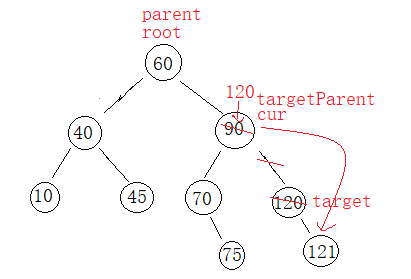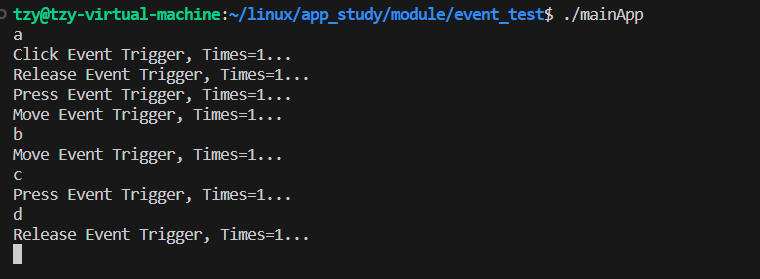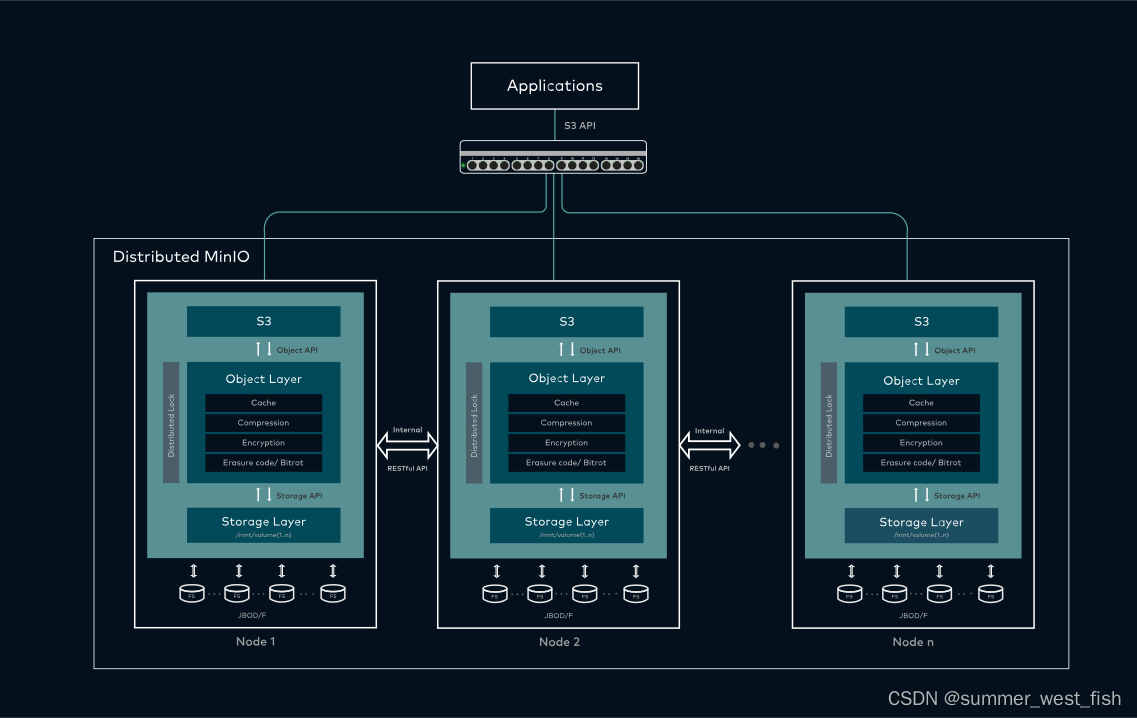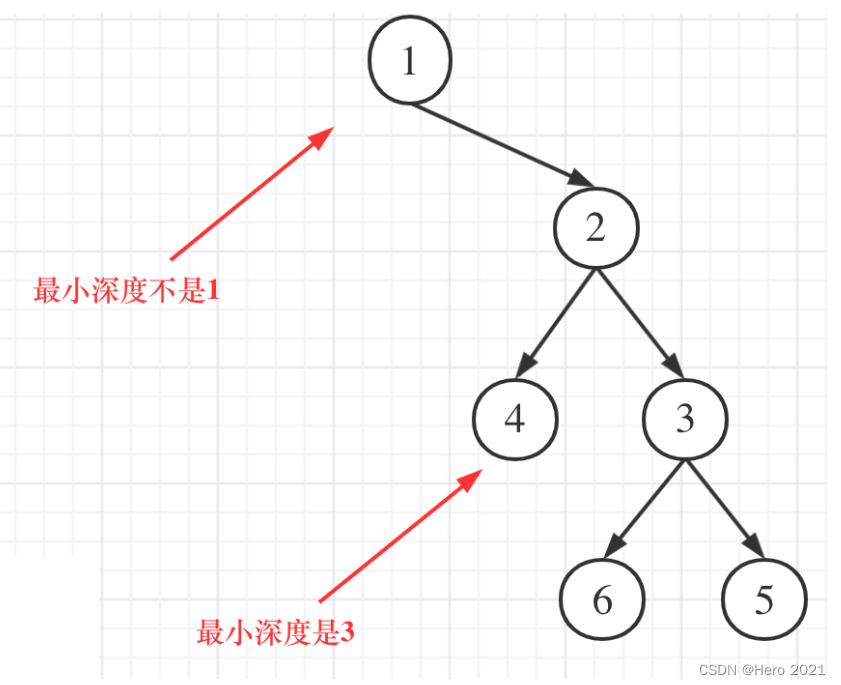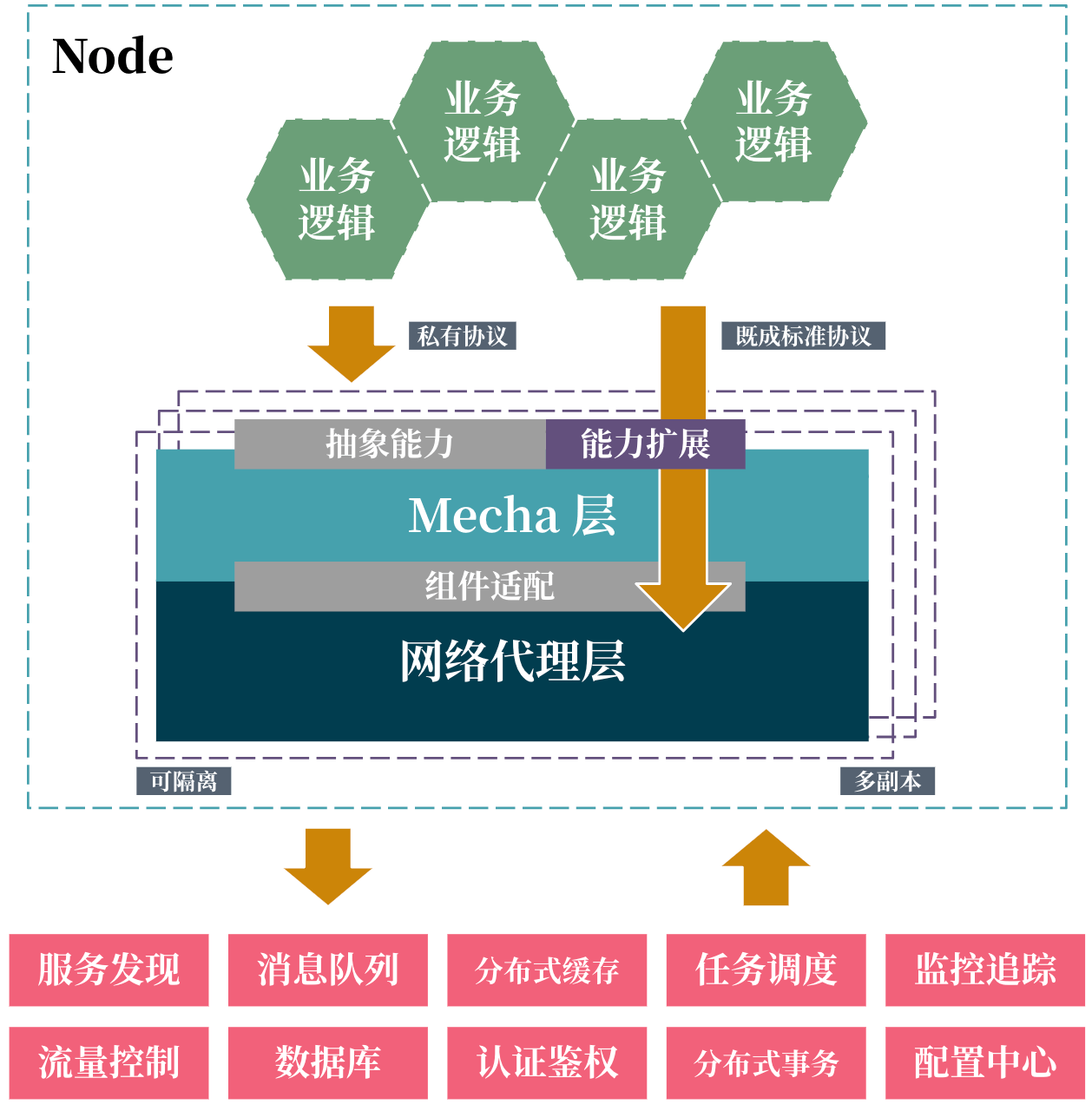1.构造函数和析构函数
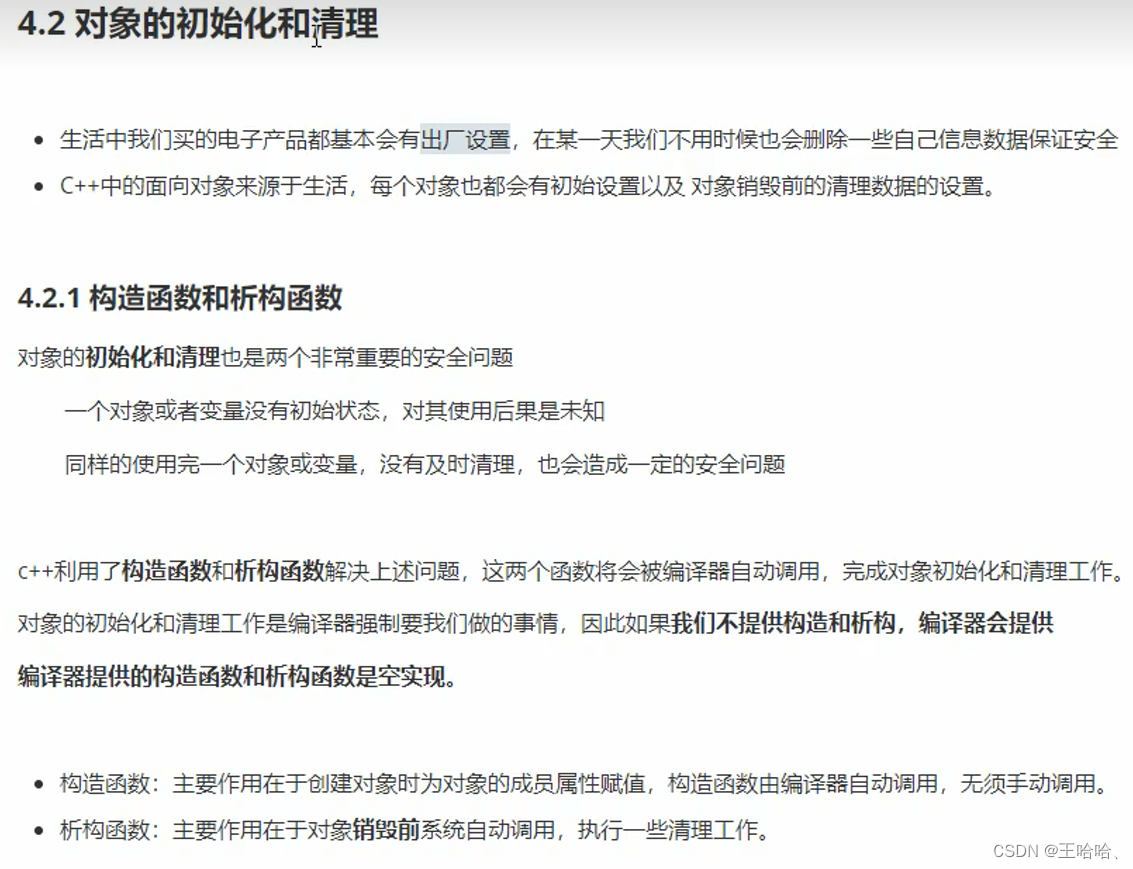
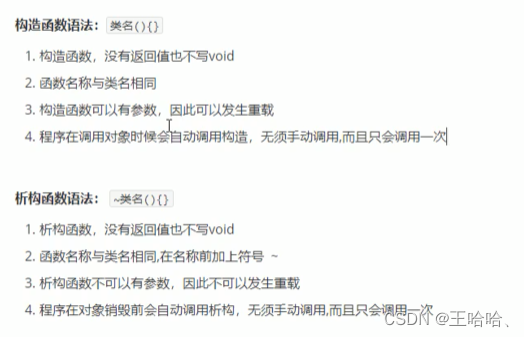
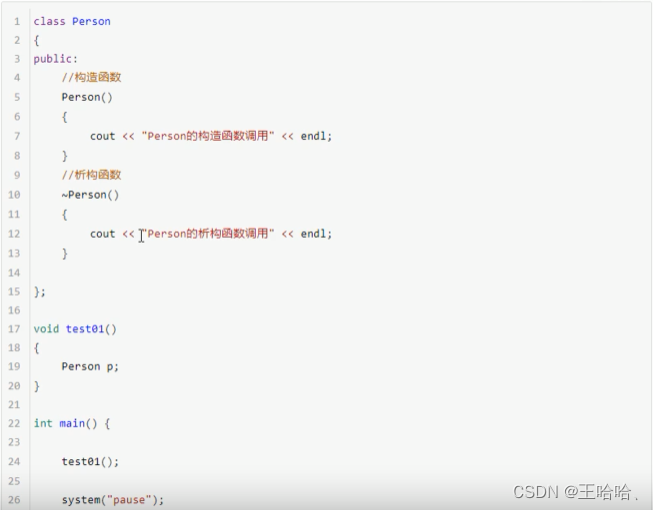
2.函数的分类以及调用
以后采用括号法
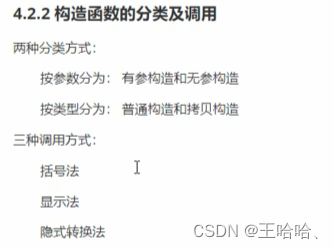
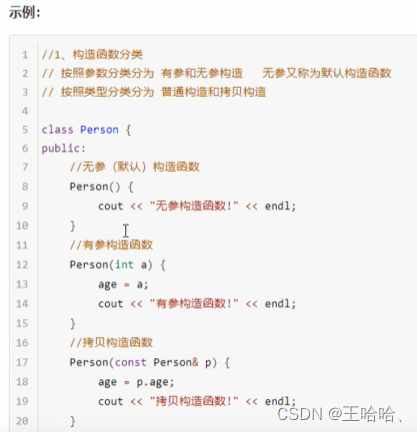
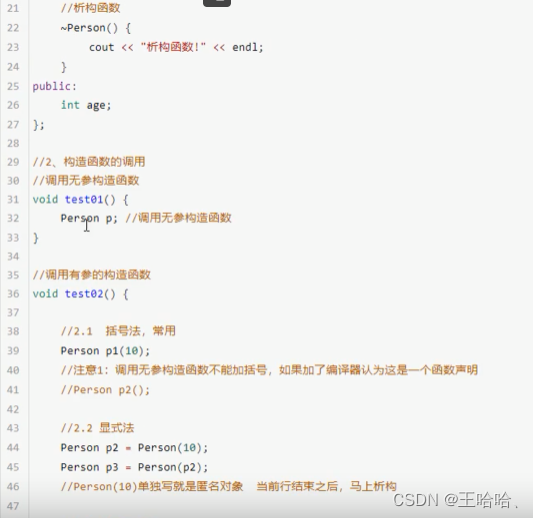

int main()
{
/******************************************/
//test01();
//test02();
Person p;
/******************************************/
system("pause");
return 0;
}
(1)以后采用括号法
Person p1; //默认构造函数调用
Person p2(10); //有参构造函数
Person p3(p1); //拷贝构造函数
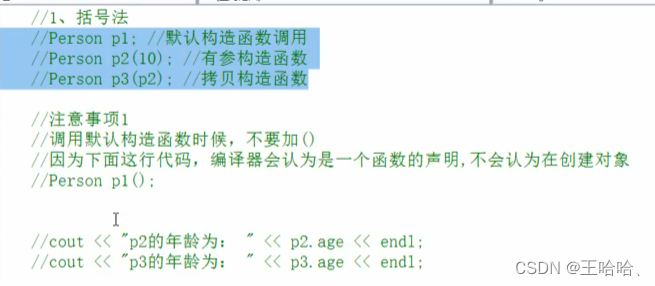
3.拷贝构造函数调用时机
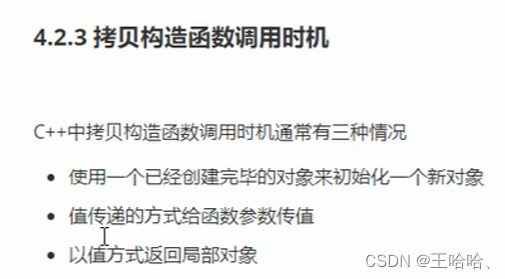
#include <iostream>
using namespace std;
/******************************************/
//拷贝构造函数调用时机
class Person {
public:
Person() {
cout << "Person默认构造函数" << endl;
}
Person(int age) {
cout << "Person有参构造函数" << endl;
m_Age = age;
}
Person(const Person& p) {
cout << "Person拷贝构造函数" << endl;
m_Age = p.m_Age;
}
~Person() {
cout << "Person析构函数" << endl;
}
int m_Age;
};
//1、使用一个已经创建完毕的对象来初始化一个新对象
void test01() {
Person p1(10);
Person p2(p1);
cout << "p2的年龄为: " << p2.m_Age << endl;
}
//2、值传递的方式给函数参数传值
void doWork( Person p) {
}
void test02() {
Person p;
doWork(p);
}
//3、值方式返回局部对象
Person doWork2() {
Person p1;
cout << (int*) & p1 << endl;
return p1;
}
void test03() {
Person p2 = doWork2();
cout << (int*) & p2 << endl;
}
/******************************************/
int main()
{
/******************************************/
test01();
test02();
test03();
/******************************************/
system("pause");
return 0;
}
4.构造函数调用规则
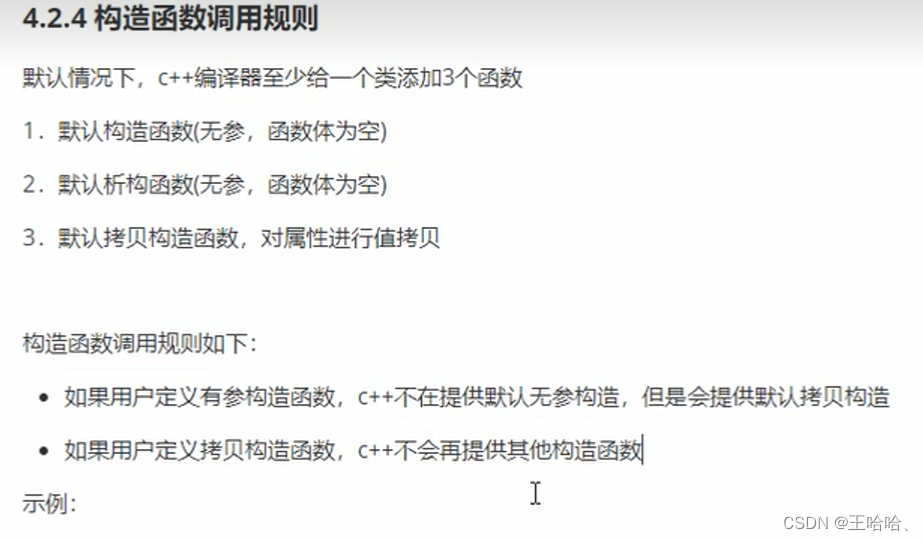
#include <iostream>
using namespace std;
/******************************************/
//构造函数的调用规则
//1、创建一个类,C++编译器会给每个类都添加至少三个函数:
//默认构造 (空实现)
//析构函数 (空实现)
//拷贝构造 (值拷贝)
//2、
//如果我们写了有参构造函数,编译器就不再提供默认构造,依然提供拷贝构造
//如果我们写了拷贝构造函数,编译器就不再提供其他普通构造函数了
class Person {
public:
//Person() {
// cout << "Person默认构造函数" << endl;
//}
//Person(int age) {
// cout << "Person有参构造函数" << endl;
// m_Age = age;
//}
Person(const Person& p) {
cout << "Person拷贝构造函数" << endl;
m_Age = p.m_Age;
}
~Person() {
cout << "Person析构函数" << endl;
}
int m_Age;
};
//void test01() {
// Person p;
// p.m_Age = 18;
// Person p2(p);
//
// cout << "p2的年龄为:" << p2.m_Age << endl;
//}
void test02() {
Person p(10);
Person p2(p);
cout << "p2的值:" << p2.m_Age << endl;
}
/******************************************/
int main()
{
/******************************************/
//test01();
test02();
/******************************************/
system("pause");
return 0;
}
5.深拷贝与浅拷贝
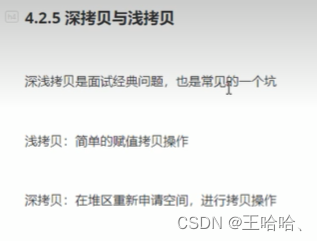

#include <iostream>
using namespace std;
/******************************************/
//深拷贝与浅拷贝
class Person {
public:
Person() {
cout << "Person默认构造函数调用" << endl;
}
Person(int age, int height) {
cout << "Person有参构造函数调用" << endl;
m_Age = age;
m_Height = new int(height);//在堆区开辟数据,并返回的是地址
}
Person(const Person& p) {
cout << "Person拷贝构造函数调用" << endl;
m_Age = p.m_Age;
}
~Person() {
if (m_Height != NULL) {
delete m_Height;//释放堆区数据
m_Height = NULL;//防止野指针的出现
}
cout << "Person析构函数调用" << endl;
}
int m_Age;//年龄
int* m_Height;//身高
};
void test01() {
Person p1(18, 180);
cout << "p1的年龄为:" << p1.m_Age << "p1的身高为:" << *p1.m_Height << endl;
Person p2(p1);
cout << "p1的年龄为:" << p2.m_Age << "p2的身高为:" << *p2.m_Height << endl;
}
/******************************************/
int main()
{
/******************************************/
test01();
/******************************************/
system("pause");
return 0;
}
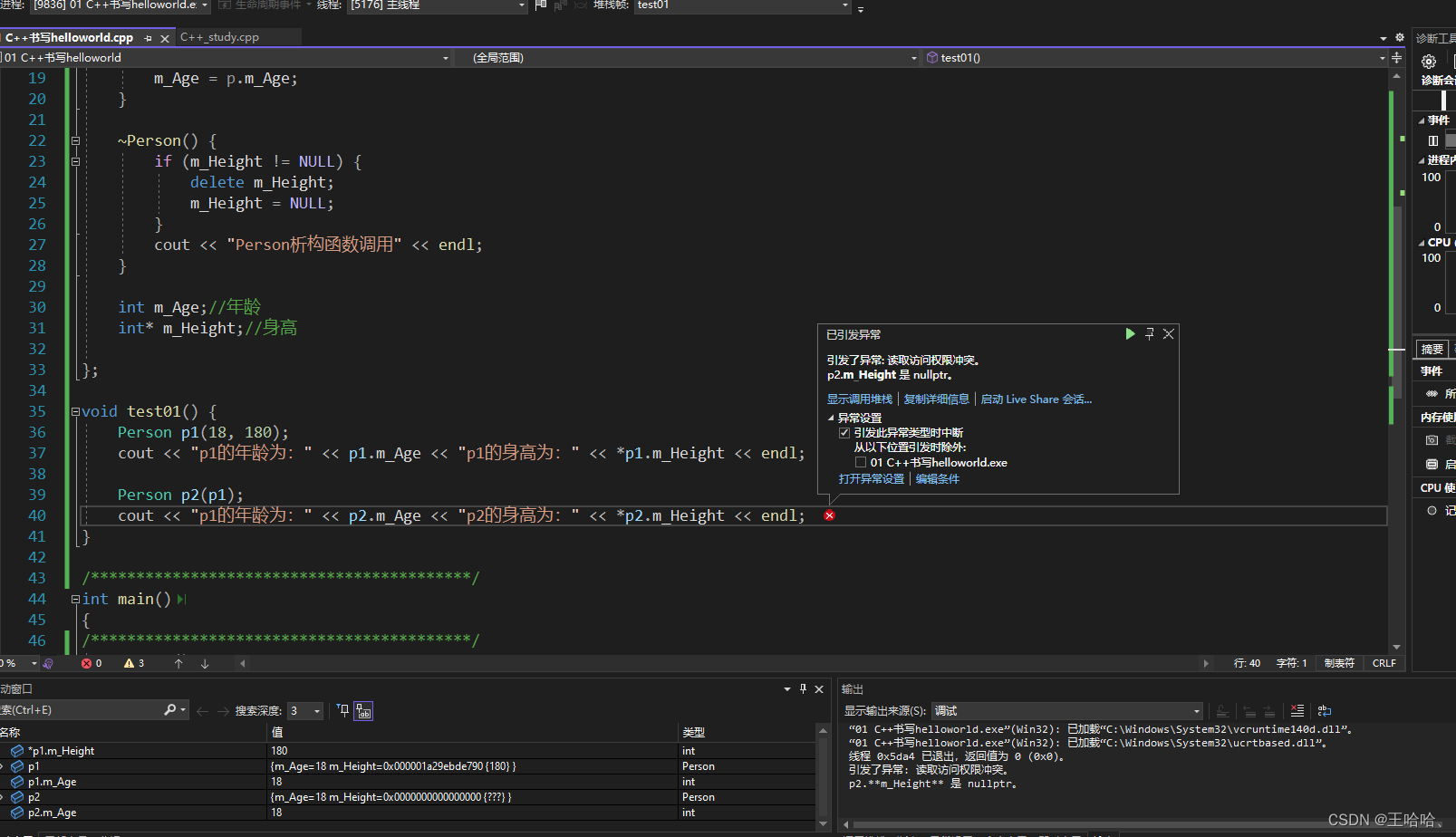
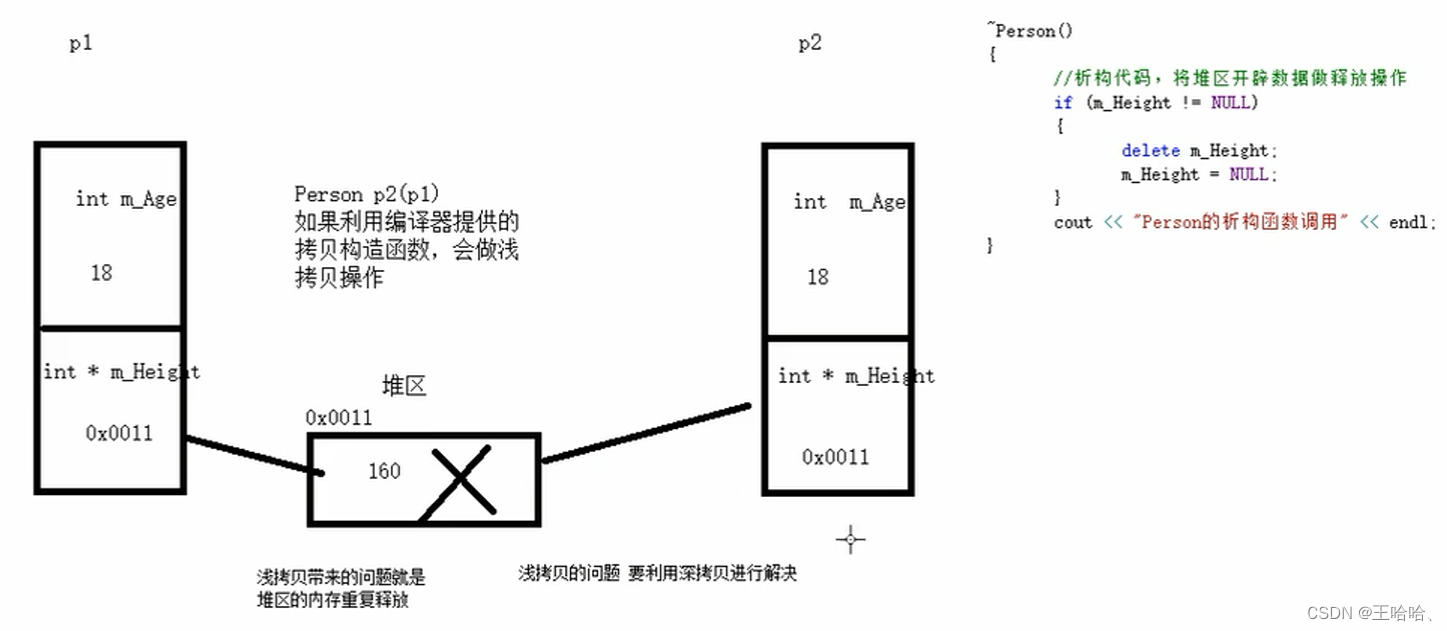
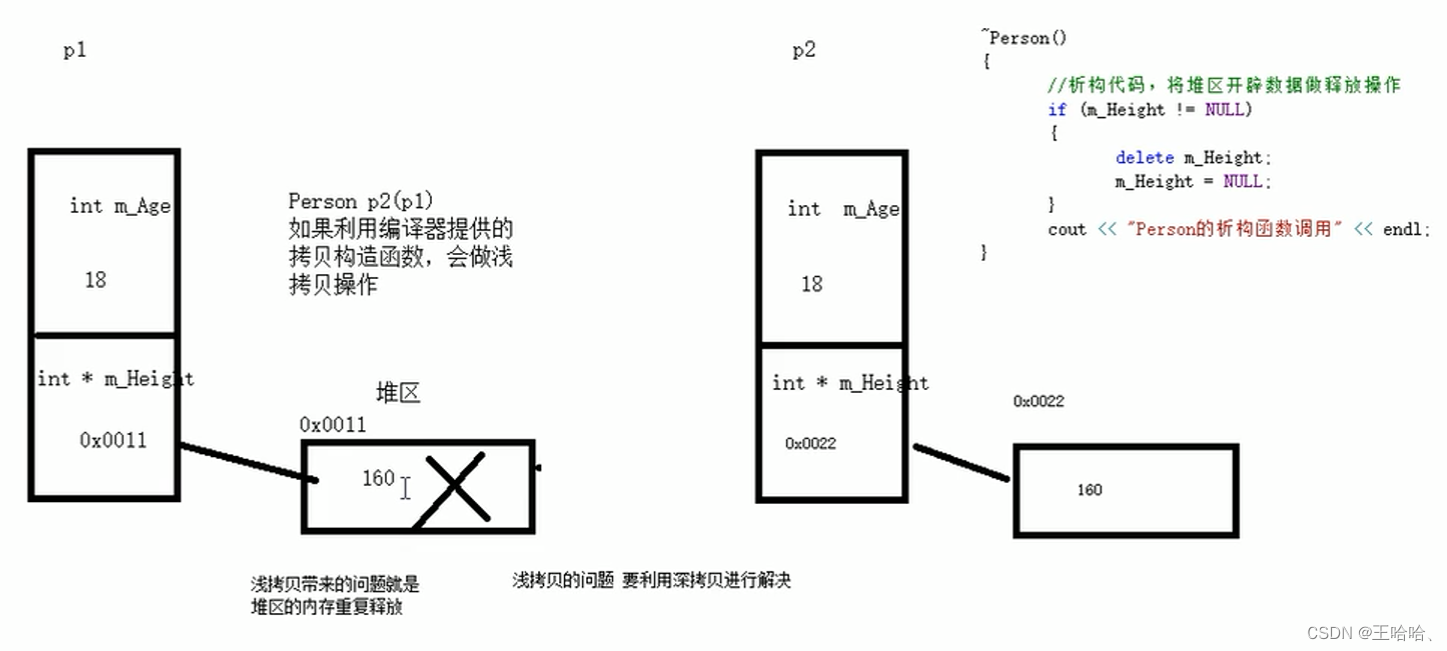
解决方式:
//自己实现拷贝构造函数 解决浅拷贝带来的问题
Person(const Person& p) {
cout << "Person拷贝构造函数调用" << endl;
m_Age = p.m_Age;
//m_Height = p.m_Height;//编译器默认实现的就是这行代码
//深拷贝操作
m_Height = new int(*p.m_Height);
}
总代码:
#include <iostream>
using namespace std;
/******************************************/
//深拷贝与浅拷贝
class Person {
public:
Person() {
cout << "Person默认构造函数调用" << endl;
}
Person(int age, int height) {
cout << "Person有参构造函数调用" << endl;
m_Age = age;
m_Height = new int(height);//在堆区开辟数据,并返回的是地址
}
//自己实现拷贝构造函数 解决浅拷贝带来的问题
Person(const Person& p) {
cout << "Person拷贝构造函数调用" << endl;
m_Age = p.m_Age;
//m_Height = p.m_Height;//编译器默认实现的就是这行代码
//深拷贝操作
m_Height = new int(*p.m_Height);
}
~Person() {
if (m_Height != NULL) {
delete m_Height;
m_Height = NULL;
}
cout << "Person析构函数调用" << endl;
}
int m_Age;//年龄
int* m_Height;//身高
};
void test01() {
Person p1(18, 180);
cout << "p1的年龄为:" << p1.m_Age << "p1的身高为:" << *p1.m_Height << endl;
Person p2(p1);
cout << "p1的年龄为:" << p2.m_Age << "p2的身高为:" << *p2.m_Height << endl;
}
/******************************************/
int main()
{
/******************************************/
test01();
/******************************************/
system("pause");
return 0;
}
6.初始化列表
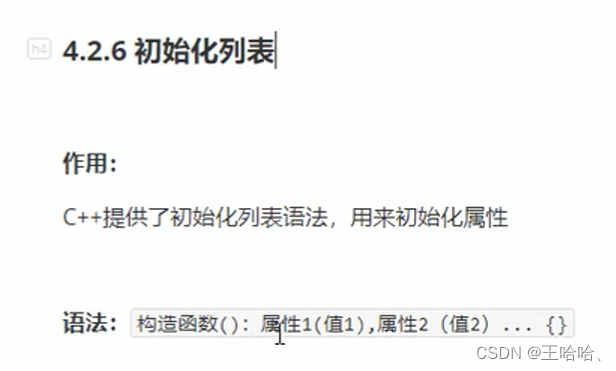
代码:
#include <iostream>
using namespace std;
/******************************************/
//初始化列表
class Person {
public:
//传统初始化操作
//Person(int a, int b, int c) {
// m_A = a;
// m_B = b;
// m_C = c;
//}
//初始化列表赋初值
Person(int a, int b, int c) :m_A(a), m_B(c), m_C(b) {
}
int m_A;
int m_B;
int m_C;
};
void test01() {
Person p(10,20,30);
cout << p.m_A << p.m_B << p.m_C << endl;
}
/******************************************/
int main()
{
/******************************************/
test01();
/******************************************/
system("pause");
return 0;
}
输出结果:

7.类对象作为类成员
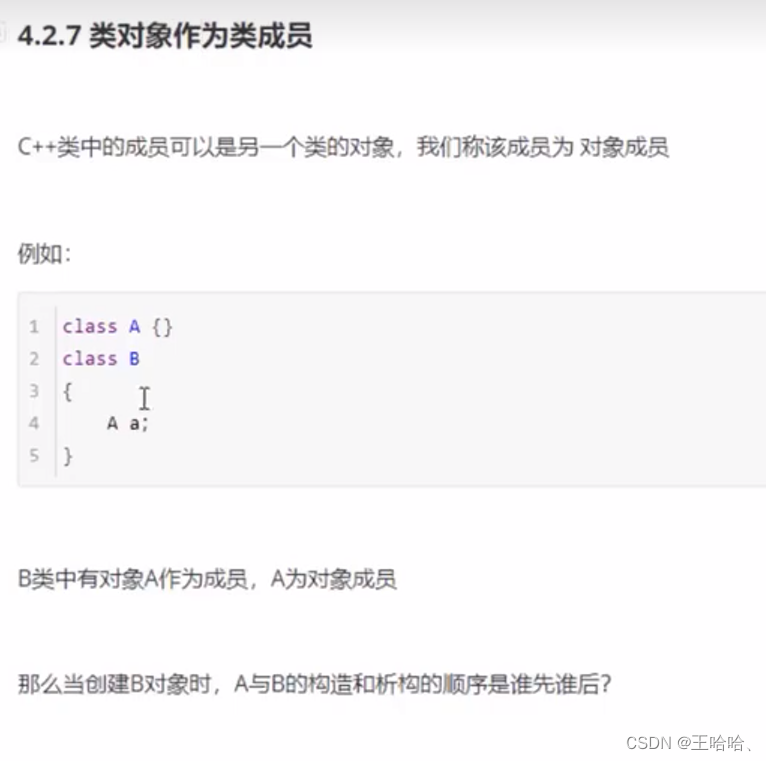
当其他类对象作为本类成员,构造时候先构造类对象,再构造自身,析构的顺序与构造相反
代码:
#include <iostream>
using namespace std;
/******************************************/
class Phone {
public:
Phone(string Pname) {
cout << "Phone的构造函数调用" << endl;
m_Pname = Pname;
}
~Phone() {
cout << "Phone的析构函数调用" << endl;
}
string m_Pname;//手机品牌
};
//人类
class Person {
public:
//m_Phone(pName)相当于Phone m_Phone = pName 隐性转换法 或 Phone m_Phone(pName) 括号法
Person(string name, string pName) :m_Name(name), m_Phone(pName) {
cout << "Person的构造函数调用" << endl;
}
~Person() {
cout << "Person的析构函数调用" << endl;
}
string m_Name;//姓名
Phone m_Phone;//手机
};
//当其他类对象作为本类成员,构造时候先构造类对象,再构造自身,析构的顺序与构造相反
void test01() {
Person p("小王", "小米K30");
cout << endl << p.m_Name<< " 拥有: " << p.m_Phone.m_Pname << endl << endl;
}
/******************************************/
int main()
{
/******************************************/
test01();
/******************************************/
system("pause");
return 0;
}
8.静态成员
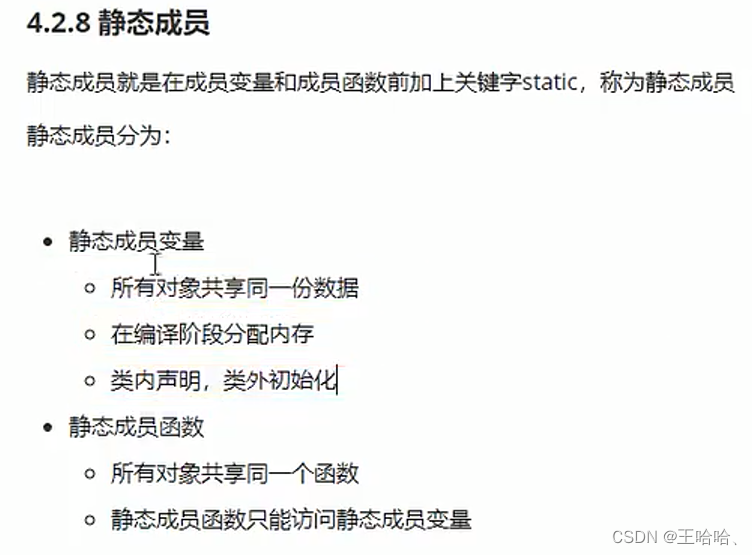
(1)静态成员变量
代码:
#include <iostream>
using namespace std;
/******************************************/
//静态成员变量
class Person {
public:
//1 所有对象都共享同一份数据
//2 编译阶段就分配内存
//3 类内声明,类外初始化操作
static int m_A;
//静态成员变量也有访问权限
private:
static int m_B;
};
int Person::m_A = 100;//类外初始化操作
int Person::m_B = 200;//类外初始化操作
void test01() {
Person p;
//100
cout << p.m_A << endl;
Person p2;
p2.m_A = 200;
//200
cout << p.m_A << endl;
}
void test02() {
//静态成员变量 不属于某个对象上,所有对象都共享同一份数据
//因此静态成员变量有两种访问方式
//1、通过对象进行访问
//person p;
//cout << p.m_a << endl;
//2、通过类名进行访问
cout << Person::m_A << endl;
//cout << Person::m_B << endl;//类外访问不到私有静态成员变量(见于14、15行代码)
}
/******************************************/
int main()
{
/******************************************/
//test01();
test02();
/******************************************/
system("pause");
return 0;
}
(2)静态成员函数
代码:
#include <iostream>
using namespace std;
/******************************************/
//静态成员函数
//1、所有对象共享同一份函数
//2、静态成员函数只能访问静态成员变量
class Person {
public:
//静态成员函数
static void func() {
m_A = 100;//静态成员函数可以访问 静态成员变量
//m_B = 200;//静态成员函数不可以访问 非静态成员变量,无法区分到底是哪个对象的m_B属性
cout << "static void func()调用" << endl;
}
static int m_A;//静态成员变量
int m_B; // 非静态成员变量
//静态成员函数也有访问权限
private:
static void func2() {
cout << "static void func2()调用" << endl;
}
};
int Person::m_A = 0;
//有两种访问方式
void test01() {
//1、通过对象访问
Person p;
p.func();
//2、通过类名访问
Person::func();
//Person::func2(); 类外访问不到私有静态成员函数
}
/******************************************/
int main()
{
/******************************************/
test01();
/******************************************/
system("pause");
return 0;
}
9.成员变量和成员函数分开存储
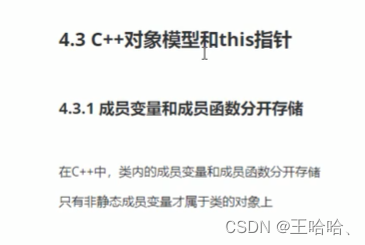
#include <iostream>
using namespace std;
/******************************************/
//成员变量 和 成员函数 分开存储的
class Person {
//public:
int m_A; //非静态成员变量 属于类的对象上
static int m_B; //静态成员变量 不属于类的对象上
void func(){} //非静态成员函数 不属于类的对象上
static void func2(){} //静态成员函数 不属于类的对象上
};
int Person::m_B = 0;
void test01() {
Person p;
//空对象占用内存空间为:1
//C++编译器会给每个空对象也分配一个字节空间,是为了区分空对象占内存的位置
//每个空对象也应该有一个独一无二的内存地址
cout << "size of p :" << sizeof(p) << endl;
}
void test02() {
Person p;
cout << "size of p :" << sizeof(p) << endl;
}
/******************************************/
int main()
{
/******************************************/
test01();
test02();
/******************************************/
system("pause");
return 0;
}
10.this指针的用途
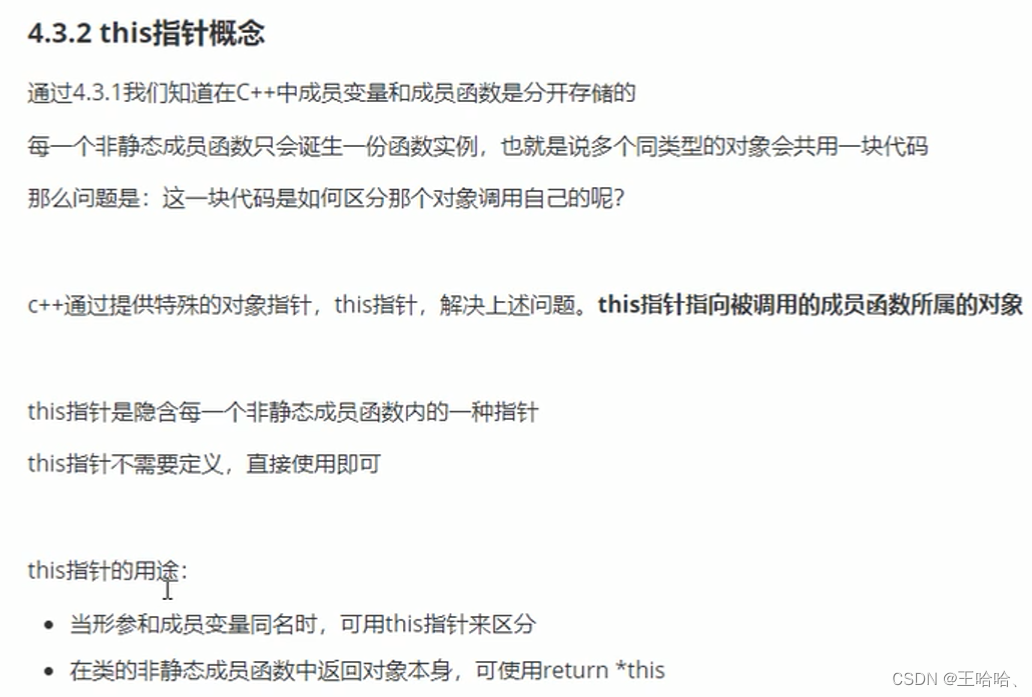
#include <iostream>
using namespace std;
/******************************************/
//1、解决名称冲突
//2、返回对象本身用*this
class Person {
public:
Person(int age) {
//this指针指向 被调用的成员函数所属的对象
this->age = age;
}
Person& PersonAddAge(Person& p) {
this->age += p.age;
//this指向p2的指针,而*this指向的就是p2这个对象本体
return *this;
}
int age;//可以直接把age改成m_Age,就不用this了
};
//1、解决名称冲突
void test01() {
Person p(12);
cout << p.age << endl;
}
//2、返回对象本身用*this
void test02() {
Person p1(10);
Person p2(10);
//链式编程思想
p2.PersonAddAge(p1).PersonAddAge(p1).PersonAddAge(p1);
cout << p2.age << endl;
}
/******************************************/
int main()
{
/******************************************/
test01();
test02();
/******************************************/
system("pause");
return 0;
}
结果
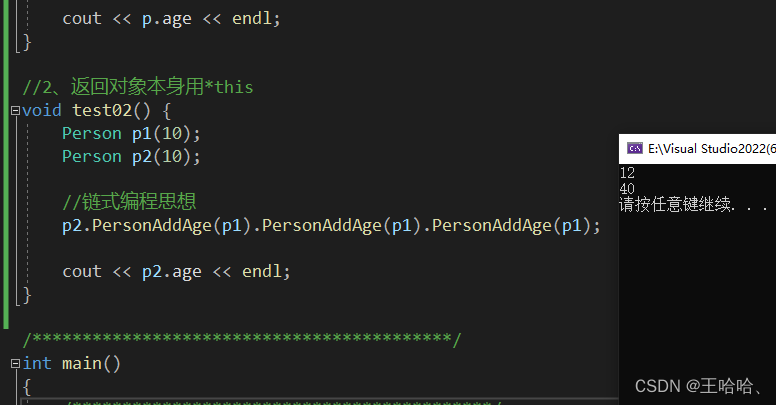
如果16-21行代码改成如下:
Person PersonAddAge(Person& p) {
this->age += p.age;
//this指向p2的指针,而*this指向的就是p2这个对象本体
return *this;
}
则:
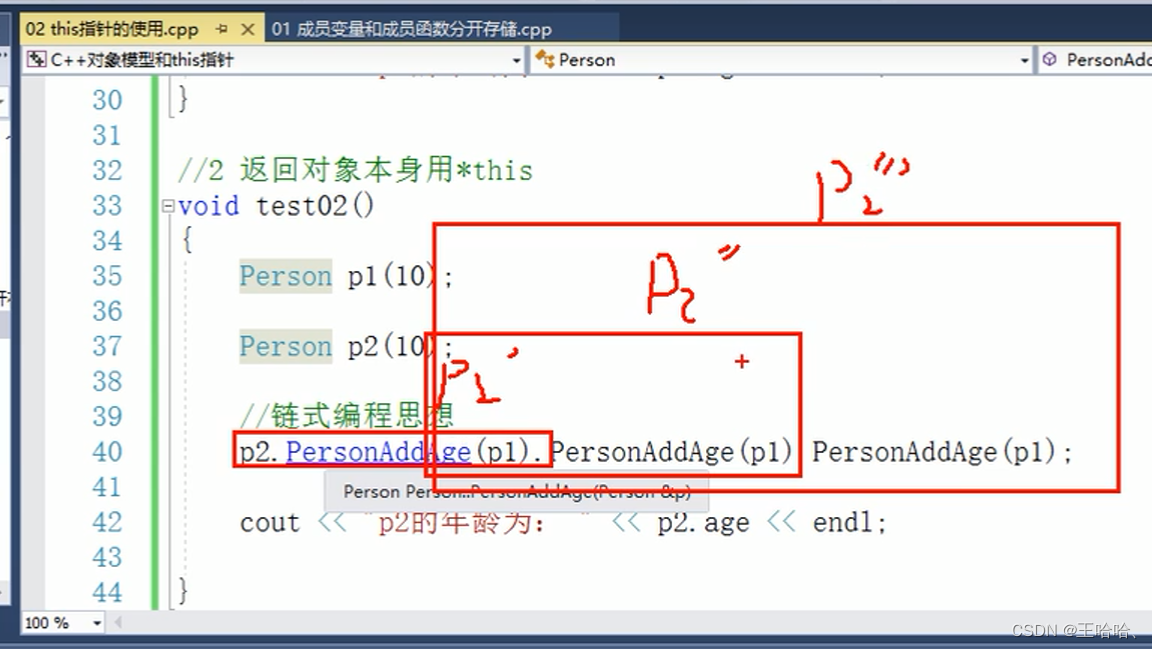
Person PersonAddAge(Person& p){
}
它是拷贝构造函数
11.空指针访问成员函数
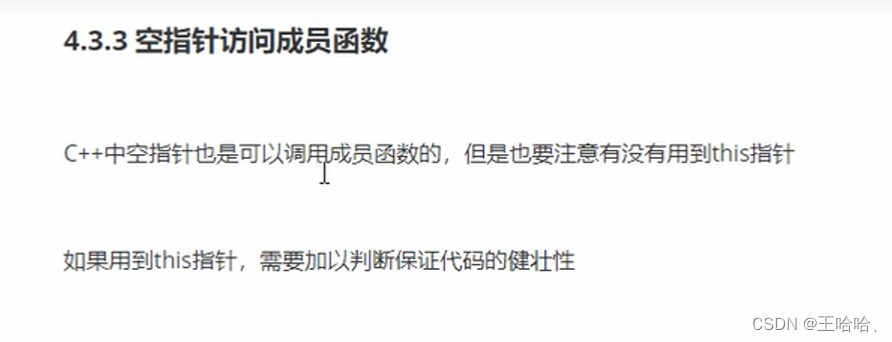
#include <iostream>
using namespace std;
/******************************************/
//空指针调用成员函数
class Person
{
public:
void showClassName()
{
cout << "this is Person class" << endl;
}
void showPersonAge() {
//报错原因是因为传入的指针是为NULL
if (this == NULL) {
return;
}
cout << "age = " << m_Age << endl;//相当于cout << "age = " << this->m_Age << endl;
}
int m_Age;
};
void test01() {
Person* p = NULL;
p->showClassName();
p->showPersonAge();
}
/******************************************/
int main()
{
/******************************************/
test01();
/******************************************/
system("pause");
return 0;
}
12.const修饰成员函数
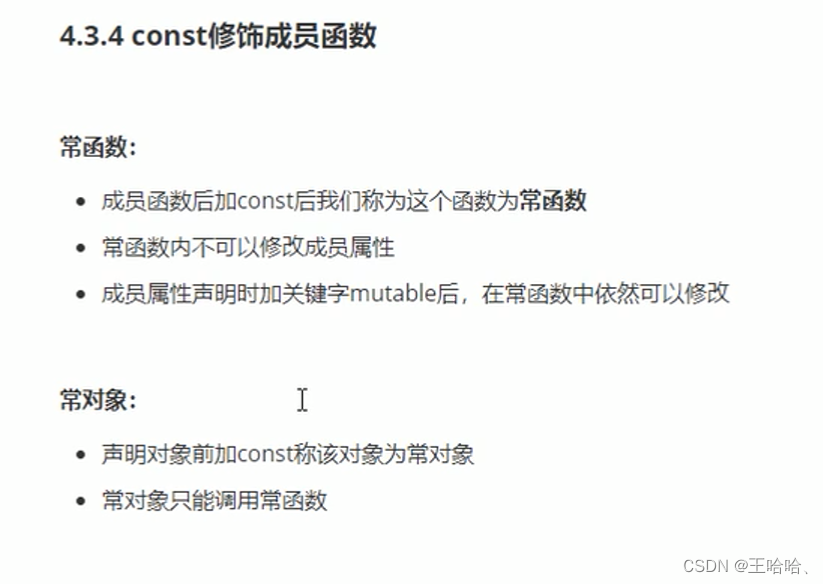
#include <iostream>
using namespace std;
/******************************************/
//常函数
class Person {
public:
//this指针的本质 是指针常量 指针的指向是不可以修改的
//const Person* const this;
//在成员函数后面加const,修饰的是this指向,让指针指向的值也不可以修改
void showPerson() const{
this->m_B = 100;
//this->m_A = 100;
//this = NULL;//this指针不可以修改指针的指向的
}
void func() {
m_A = 100;
}
int m_A;
mutable int m_B;//特殊变量,即使在常函数中,也可以修改这个值,加关键字mutable
};
void test01() {
Person p;
p.showPerson();
cout << p.m_B;
}
void test02() {
const Person p;//在对象前加const,变为常对象
//p.m_A = 100;//左值不能修改
p.m_B = 100;//m_B是特殊值,在常对象下也可以修改
//常对象只能调用常函数
p.showPerson();
//p.func();//常对象 不可以调用普通成员函数,因为普通成员函数可以修改属性
}
/******************************************/
int main()
{
/******************************************/
test01();
/******************************************/
system("pause");
return 0;
}

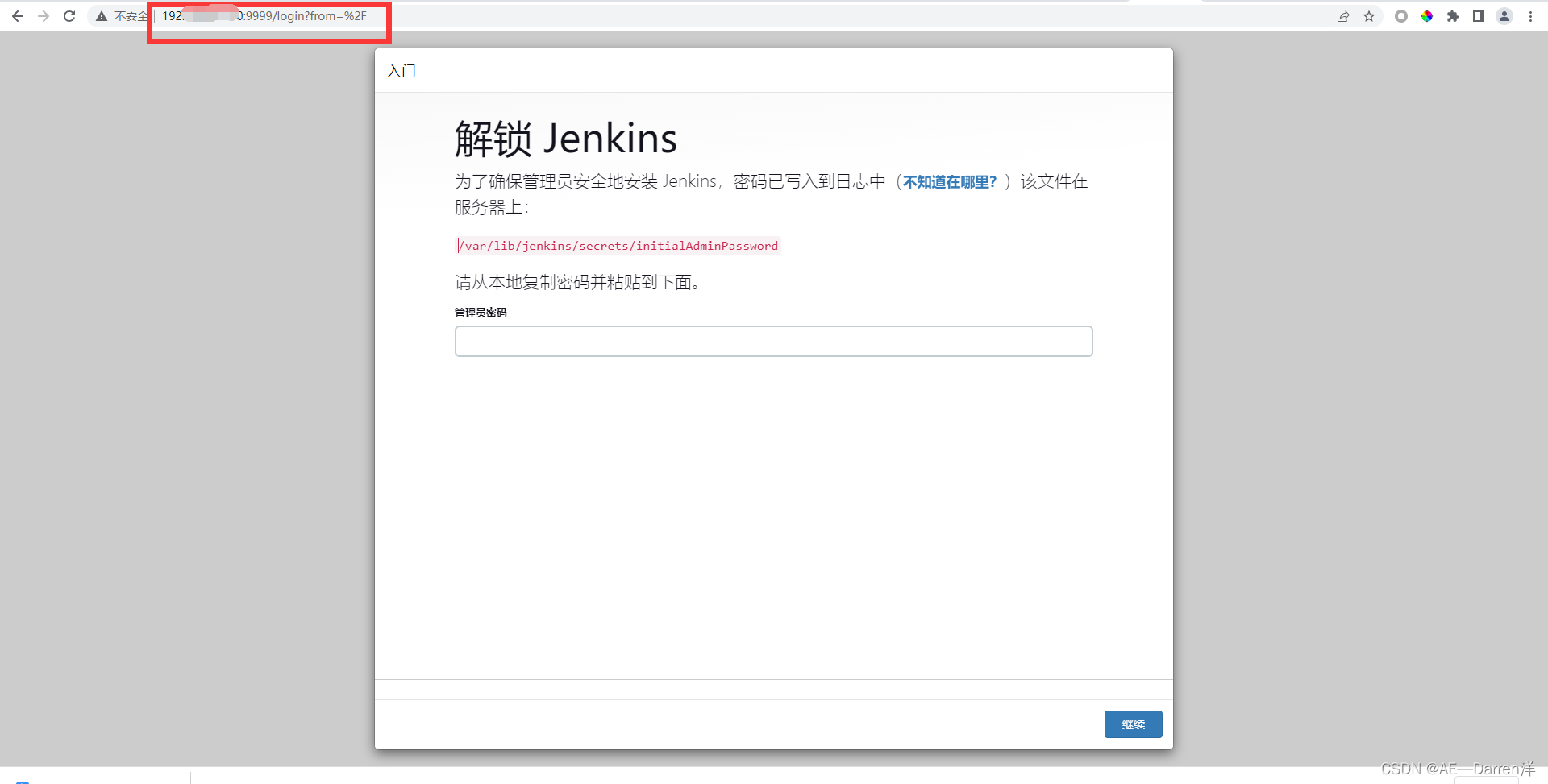
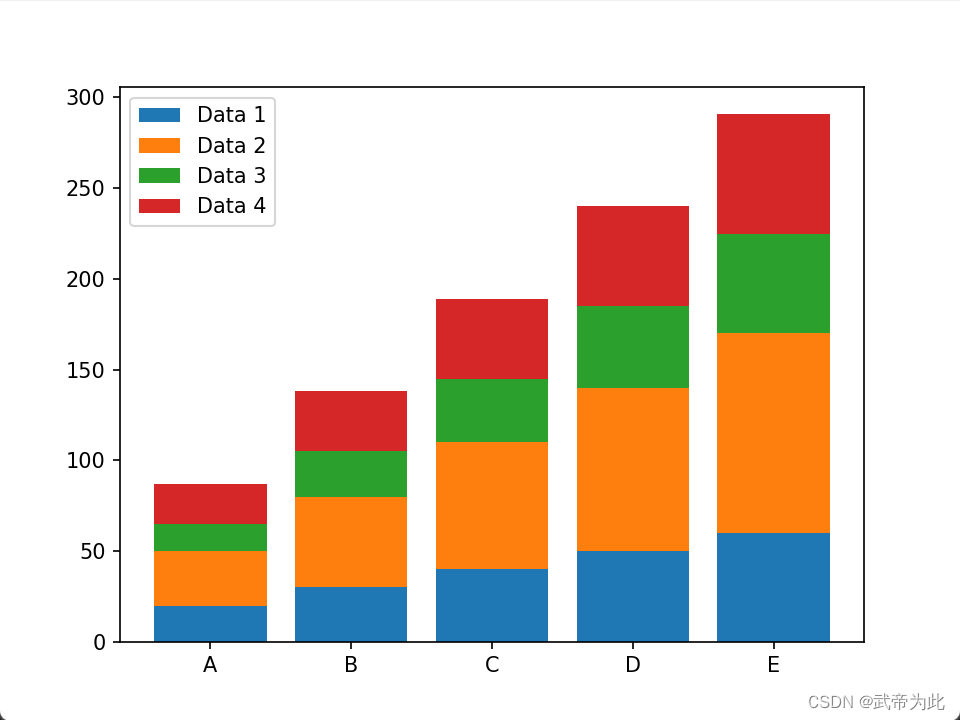


![#P1006. [NOIP2010普及组] 三国游戏](https://img-blog.csdnimg.cn/img_convert/8ace70d8c955e6f1b4349b6a2c09fb02.png)

